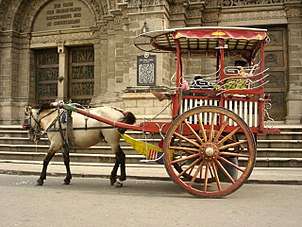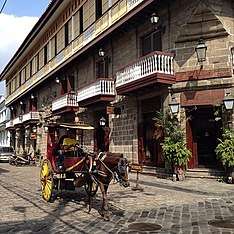Kalesa
| Kalesa | |
|---|---|
 A kalesa in Manila | |
| Application | Transportation |
| Powered | No |
| Self-propelled | No |
| Wheels | 2 |
A kalesa (also known as carromata, caritela or karitela) is a horse-drawn calash used in the Philippines. It was one mode of transportation introduced to the islands in the 18th century by Spanish colonizers, and was initially reserved for only nobles and high-ranking civic officials.[1] They are rarely used in the streets today, except in the tourist-frequented areas of old cities and some rural areas.
Composer Ambrosio Del Rosario composed the original music and National Artist of the Philippines Levi Celério wrote the lyrics for a song entitled Kalesa, in honour of the vehicle.[2]
Etymology
The word, also spelt calesa as in the original Spanish, is related to the terms calèche and was already in Spain prior to its colonisation of the islands. The term ultimately descends from an Old Church Slavonic word meaning "wheels."

Characteristics

A kalesa looks like an inclined cart, and is drawn by a single horse. It has two round wheels on each side and two rows of seats that can accommodate four persons. The driver sits on a block of wood located at the front of the cart near the horse.
Uses for transportation

When the kalesa was introduced in the 18th century, it grew into a significant mode of transportation in the islands. Rich, educated Filipinos known as the ilustrados used the kalesa for personal travel as well as for the transport of goods to nearby areas.[3] During the American Occupation, the City of Manila was teeming with kalesas, but these declined in popularity after the devastation of the Second World War.
The kalesa driver is commonly called as kutsero (Tagalised from cochero, "car driver"). When a kutsero wants the horse to turn right, he says "mano” while he says "silla” to make the horse turn left.[4]
Extent of use
Although the kalesa has become a rarity, century-old examples are still preserved in areas of the Philippines, such as in Vigan and Laoag.[3] Kalesas can also be found in Intramuros, where they cater to tourists and Binondo in Manila, as well as in Iligan, where decorated kalesas can be taken for a ride along a specific street. In Cagayan, kalesas are common, especially in Tuao and other municipalities of the province. In Tuguegarao, the carriages are a part of the traffic along with private cars, motorcycles, tricycles, jeepneys, trucks, and bicycles.
Notes
- ↑ Kalesa, the 18th Centuries Rolls Royce. Philippines Travel Guide for the explorer in you.
- ↑ Kalesa - Video Watch, watch Youtube video, download Youtube video.
- 1 2 Kalesa. Archived 2007-11-11 at the Wayback Machine. Vigan City Philippines - Unesco World Heritage City.
- ↑ Riding The Philippine 'Calesa' and Business
- Kalesa de Cebu
- Philippines Travel Guide for the explorer in you.
- Riding The Philippine 'Calesa' and Business
- Kalesa - Video Watch, watch Youtube video, download Youtube video.
 Kalesa in Manila
Kalesa in Manila - Vigan City Philippines - Unesco World Heritage City.
- Kalesa Kinulayan Philippines People's Organization, Inc. website
- Lifestylebucket Blogsite
References
- "Breve diccionario etimológico de la lengua española" by Guido Gómez de Silva ( ISBN 968-16-2812-8)
- PTA Grand Launch - Kalesa Festival. The Official Web Page of Philippine Tourism Authority.
- Kalesa Kinulayan Philippines People's Organization, Inc. website
- Lifestylebucket Blogsite